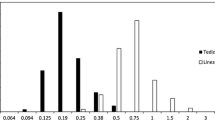Abstract
The aim of this work was to determine the in vitro activity of tigecycline and its bactericidal effect for a large number of Gram-positive cocci, as well as to investigate its in vitro interaction with six clinically used antibiotics. In vivo, a wound model was established through the panniculus carnosus of BALB/c mice, and then inoculated with 5 × 107 colony-forming units (CFU) of Staphylococcus aureus or Enterococcus faecalis. For each bacterial strain, the study included an infected or non-infected group that did not receive any treatment, three groups singly treated with tigecycline, rifampin, and daptomycin, and two groups that received tigecycline treatment plus rifampin or daptomycin. In the in vitro studies, tigecycline, daptomycin, and teicoplanin were active against all of the 48 Gram-positive isolates. The combination of tigecycline with rifampicin and daptomycin was synergistic against S. aureus and Enterococcus spp. In the in vivo studies, all groups treated with single drugs showed statistically significant results compared to the control group. The two groups treated with a combination of drugs showed the highest antimicrobial efficacy. In conclusion, our results suggested a strong activity of tigecycline alone and in combination with other antimicrobial agents against multi-resistant Gram-positive organisms isolated from wound infections.


Similar content being viewed by others
References
Cormican MG, Jones RN (1996) Emerging resistance to antimicrobial agents in Gram-positive bacteria. Enterococci, staphylococci and nonpneumococcal streptococci. Drugs 51:S6–S12
Linden PK (1998) Clinical implications of nosocomial gram-positive bacteremia and superimposed antimicrobial resistance. Am J Med 104:24S–33S
Bratzler DW, Houck PM; Surgical Infection Prevention Guidelines Writers Workgroup et al (2004) Antimicrobial prophylaxis for surgery: an advisory statement from the National Surgical Infection Prevention Project. Clin Infect Dis 38:1706–1715
Burke JP (2003) Infection control—a problem for patient safety. N Engl J Med 348:651–656
Hirsch T, Koerber A, Jacobsen F et al (2010) Evaluation of toxic side effects of clinically used skin antiseptics in vitro. J Surg Res 164:344–350
El-Azizi M, Rao S, Kanchanapoom T et al (2005) In vitro activity of vancomycin, quinupristin/dalfopristin, and linezolid against intact and disrupted biofilms of staphylococci. Ann Clin Microbiol Antimicrob 4:2
Lode HM (2009) Clinical impact of antibiotic-resistant Gram-positive pathogens. Clin Microbiol Infect 15:212–217
Bouza E (2009) New therapeutic choices for infections caused by methicillin-resistant Staphylococcus aureus. Clin Microbiol Infect 15(Suppl 7):44–52
Moellering RC Jr (1998) Problems with antimicrobial resistance in gram-positive cocci. Clin Infect Dis 26:1177–1178
Arias CA, Contreras GA, Murray BE (2010) Management of multidrug-resistant enterococcal infections. Clin Microbiol Infect 16:555–562
Diekema DJ, BootsMiller BJ, Vaughn TE et al (2004) Antimicrobial resistance trends and outbreak frequency in United States hospitals. Clin Infect Dis 38:78–85
Giacometti A, Cirioni O, Kamysz W et al (2005) In vitro activity and killing effect of temporin A on nosocomial isolates of Enterococcus faecalis and interactions with clinically used antibiotics. J Antimicrob Chemother 55:272–274
Spellberg B, Guidos R, Gilbert D et al (2008) The epidemic of antibiotic-resistant infections: a call to action for the medical community from the Infectious Diseases Society of America. Clin Infect Dis 46:155–164
Montefour K, Frieden J, Hurst S et al (2008) Acinetobacter baumannii: an emerging multidrug-resistant pathogen in critical care. Crit Care Nurse 28:15–25
Labthavikul P, Petersen PJ, Bradford PA (2003) In vitro activity of tigecycline against Staphylococcus epidermidis growing in an adherent-cell biofilm model. Antimicrob Agents Chemother 47:3967–3969
Clinical and Laboratory Standards Institute (CLSI) (2003) Methods for dilution antimicrobial susceptibility tests for bacteria that grow aerobically. Approved standard M7-A6. National Committee for Clinical Laboratory Standards (NCCLS), Villanova, PA
Petersen PJ, Labthavikul P, Jones CH (2006) In vitro antibacterial activities of tigecycline in combination with other antimicrobial agents determined by chequerboard and time–kill kinetic analysis. J Antimicrob Chemother 57:573–576
Rand KH, Houck HJ, Brown P et al (1993) Reproducibility of the microdilution checkerboard method for antibiotic synergy. Antimicrob Agents Chemother 37:613–615
Simonetti O, Cirioni O, Ghiselli R et al (2008) RNAIII-inhibiting peptide enhances healing of wounds infected with methicillin-resistant Staphylococcus aureus. Antimicrob Agents Chemother 52:2205–2211
Kugelberg E, Norström T, Petersen TK et al (2005) Establishment of a superficial skin infection model in mice by using Staphylococcus aureus and Streptococcus pyogenes. Antimicrob Agents Chemother 49:3435–3441
Lin MY, Hayden MK (2010) Methicillin-resistant Staphylococcus aureus and vancomycin-resistant Enterococcus: recognition and prevention in intensive care units. Crit Care Med 38:S335–S344
Peterson LR (2008) A review of tigecycline—the first glycylcycline. Int J Antimicrob Agents 32:S215–S222
Hoban DJ, Bouchillon SK, Johnson BM et al; Tigecycline Evaluation and Surveillance trial (TEST Program) Group (2005) In vitro activity of tigecycline against 6792 Gram-negative and Gram-positive clinical isolates from the global Tigecycline Evaluation and Surveillance Trial (TEST Program, 2004). Diagn Microbiol Infect Dis 52:215–227
Moland ES, Craft DW, Hong SG et al (2008) In vitro activity of tigecycline against multidrug-resistant Acinetobacter baumannii and selection of tigecycline–amikacin synergy. Antimicrob Agents Chemother 52:2940–2942
Rathe M, Kristensen L, Ellermann-Eriksen S et al (2010) Vancomycin-resistant Enterococcus spp.: validation of susceptibility testing and in vitro activity of vancomycin, linezolid, tigecycline and daptomycin. APMIS 118:66–73
Farrell DJ, Turnidge JD, Bell J et al (2010) The in vitro evaluation of tigecycline tested against pathogens isolated in eight countries in the Asia-Western Pacific region (2008). J Infect 60:440–451
Ippolito G, Leone S, Lauria FN et al (2010) Methicillin-resistant Staphylococcus aureus: the superbug. Int J Infect Dis 14(Suppl 4):S7–S11
Entenza JM, Moreillon P (2009) Tigecycline in combination with other antimicrobials: a review of in vitro, animal and case report studies. Int J Antimicrob Agents 34:8.e1–8.e9
Rybak MJ, McGrath BJ (1996) Combination antimicrobial therapy for bacterial infections. Guidelines for the clinician. Drugs 52:390–405
Author information
Authors and Affiliations
Corresponding author
Rights and permissions
About this article
Cite this article
Silvestri, C., Cirioni, O., Arzeni, D. et al. In vitro activity and in vivo efficacy of tigecycline alone and in combination with daptomycin and rifampin against Gram-positive cocci isolated from surgical wound infection. Eur J Clin Microbiol Infect Dis 31, 1759–1764 (2012). https://doi.org/10.1007/s10096-011-1498-1
Received:
Accepted:
Published:
Issue Date:
DOI: https://doi.org/10.1007/s10096-011-1498-1




